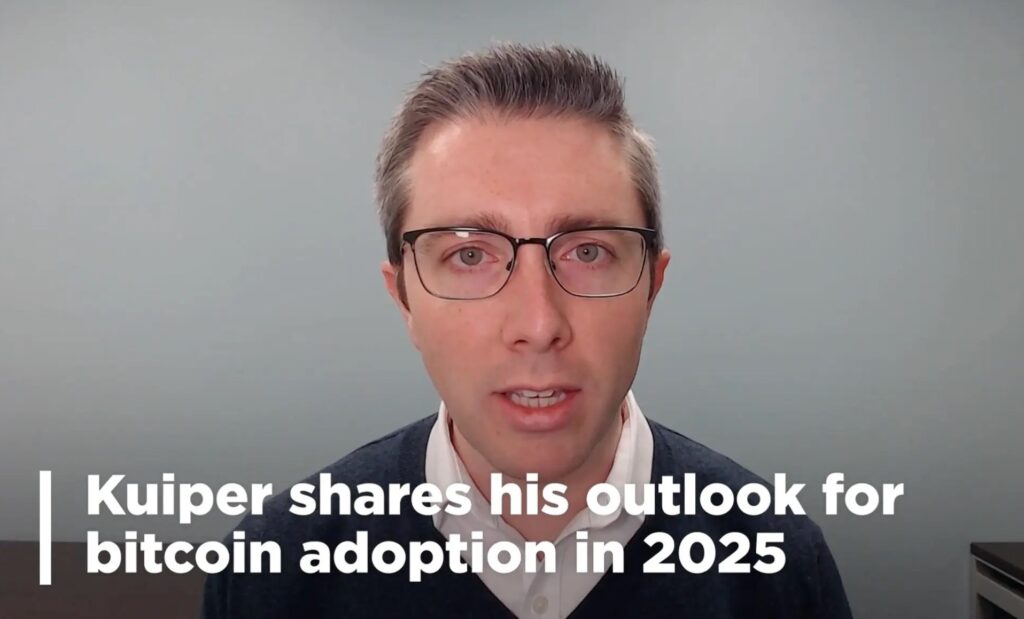The Future of Crypto in 2025: Fidelity’s Predictions

What’s next for the biggest cryptocurrencies in 2025? Fidelity Digital Assets analyst Chris Kuiper shares insights on how Bitcoin will navigate volatility, Ethereum will address scaling challenges, and stablecoins will adapt to evolving regulations.
On this page
- Mass Adoption: The Driving Force Behind Bitcoin’s Growth
- Bitcoin’s Volatility: Challenges and Opportunities
- BTC vs Stocks: A Volatility Comparison
- Ethereum: Balancing Short-Term Sacrifices with Long-Term Growth
- Stablecoins: A Growing Force in the Market
- Tokenization: The Next Growth Frontier
- Profile: Chris Kuiper
- Profile: Fidelity Digital Assets
- Chris Kuiper: Key Takeaways
Cryptocurrencies are steadily integrating into traditional finance and other industries. While 2025 holds the potential to be a groundbreaking year, the digital asset market still faces critical challenges that could shape its future.
Mass Adoption: The Driving Force Behind Bitcoin’s Growth
Chris Kuiper, director of research at Fidelity Digital Assets believes that widespread adoption will be the key to Bitcoin’s evolution in 2025.
The leading cryptocurrency has shown remarkable resilience, successfully navigating numerous regulatory cycles while maintaining its stability.
Bitcoin is apolitical. It's the most neutral commodity or form of money, however you want to think of it,
Kuiper explained.
He noted that Bitcoin, as a standalone asset class with a market capitalization that once reached $2 trillion, has naturally captured the attention of nearly every investor.
Kuiper sees 2025 as a pivotal year in Bitcoin’s trajectory. “We are entering a new era, a new chapter, in this of mass adoption and diffusion,” he said.
He predicts Bitcoin’s expansion into industries like energy and insurance, as well as its increasing role in corporate treasury strategies.

Source: CNBC
As this diffuses and permeates through all the different areas of society, we think that's going to be the major factor. But, of course, that's not just a 2025 story. That's likely a multi-year, maybe even multi-decade story,
he added.
Bitcoin’s Volatility: Challenges and Opportunities
Chris Kuiper acknowledges that Bitcoin’s inherent volatility remains a significant hurdle for many investors. According to him, Fidelity Digital Assets conducts an annual survey of institutional investors, and every year, Bitcoin’s volatility is cited as the primary barrier to investment.
However, Kuiper strongly rejects the notion that volatility is a valid reason to avoid investing, especially for institutional players.
Volatility is not a reason not to invest or just disregard something. It's a reason to manage it,
he noted.
Kuiper also argues that Bitcoin’s volatility is an essential part of its value proposition.
Bitcoin is valuable because it's volatile, and that's because it has that hard cap of 21 million coins,
he explained.
He further noted that Bitcoin’s fixed supply makes it highly sensitive to changes in demand, which drives price fluctuations. To succeed, investors need to adapt by implementing effective risk management strategies, such as adjusting position sizes or utilizing advanced investment tools.
BTC vs Stocks: A Volatility Comparison
Chris Kuiper frequently challenges the misconception that Bitcoin’s volatility is exceptionally high compared to other financial assets.
People need to look at the data, as well as they're operating on some of this old data when Bitcoin was multiple times more volatile than it is today at a two trillion-dollar asset class,
he explained.
As Bitcoin matures as an asset class, its volatility has steadily declined. Kuiper noted that Bitcoin’s current volatility is comparable to that of fast-growing tech stocks like the “Magnificent Seven”: Apple, Microsoft, Alphabet, Amazon, Nvidia, Tesla, and Meta Platforms.
Despite similar levels of volatility, these stocks have long been staples in investors’ portfolios.
We do think that 2025 could be the year where people look back and say, ‘Ah, this was the turning point,’ or, ‘This was the start of that new era,’
Kuiper said confidently.
Ethereum: Balancing Short-Term Sacrifices with Long-Term Growth
Reflecting on Ethereum’s performance in 2024, Chris Kuiper noted the “weak” momentum ETH displayed during the year. Its returns lagged behind Bitcoin and failed to meet investor expectations, with periods of zero growth year-to-date.
Ethereum eventually recovered much of its losses, particularly after the U.S. presidential election and the subsequent crypto rally. However, Kuiper predicts that, in the long term, ETH may continue to trail behind Bitcoin.

Kuiper attributes this to Ethereum’s strategic decision to prioritize scalability through Layer 2 (L2) solutions.
The community said to scale this, we're going to have this rollup-centric roadmap where we focus on moving activities to layer twos. That's going to drive down fees, and it's going to bring in more users and developers,
he explained.
However, this approach comes with inevitable trade-offs. Shifting activity to L2 blockchains has resulted in reduced revenue for Ethereum’s base layer—a trade-off Kuiper believes was a deliberate choice by its developers.
Our analyst…has been very firm in saying this was the plan all along – to sacrifice that short-term revenue for larger network effects down the road,
Kuiper said.
He also emphasized the importance of the upcoming Prague Electra (Pectra) upgrade, expected in early to mid-2025. Initially envisioned as a major overhaul, its scope has been adjusted to focus on optimizing Ethereum’s code following its transition to Proof-of-Stake and enhancing support for L2 solutions.
Related: What to Expect from Ethereum’s Pectra Upgrade?
Kuiper considers Pectra a critical milestone that will test whether the market embraces Ethereum’s strategy of prioritizing scalability over short-term profitability.
Stablecoins: A Growing Force in the Market
Discussing stablecoins, Chris highlighted their rapid ascent and growing popularity, calling them a product perfectly tailored to market needs. He underscored their crucial role in payments and remittances, driven in part by the rising global demand for the US dollar.
The dollar right now is ripping higher…so that’s certainly going to help as well,
he remarked.
Chris also noted encouraging regulatory developments that could further propel stablecoin growth in 2025. Signs of bipartisan support for legislation in this space suggest the potential for a more supportive environment to foster their adoption and innovation.
Tokenization: The Next Growth Frontier
During the interview, Chris Kuiper discussed the emerging segment of tokenizing real-world assets, emphasizing its strong growth potential.
Although still in its early stages, this market is poised for significant expansion.
It just makes sense to put a lot of these assets on-chain to benefit from all the efficiencies that they get,
Chris remarked.
He also pointed to examples like tokenized government bonds and predicted that 2025 could see wider adoption of tokenization, fueled by growing public awareness of the advantages of blockchain technology.
Profile: Chris Kuiper

Source: Linkedin
Name: Chris Kuiper
Position: Director of Research, Fidelity Digital Assets
Education
- Master’s in Economics, George Mason University
- Bachelor’s in Business Administration, Dordt University
Professional Background
Chris Kuiper, a Chartered Financial Analyst (CFA®), is the Director of Research at Fidelity Digital Assets.
Prior to joining Fidelity, he served as Vice President of Equity Research at CFRA Research, where he played a key role in expanding the firm’s research capabilities to include Bitcoin analysis. Earlier in his career, Kuiper worked as an investment analyst for various firms and as a research fellow at the Mercatus Center.
Contributions and Expertise
At Fidelity Digital Assets, Kuiper is a driving force behind the analysis and interpretation of trends in the digital asset space. His work provides critical insights that shape investment strategies in the cryptocurrency market.
Kuiper’s research and commentary have been featured across leading publications, helping institutional investors better understand the evolving digital asset landscape.
Profile: Fidelity Digital Assets

Source: Linkedin
Name: Fidelity Digital Assets
Parent Company: Fidelity Investments
Founded: 2018
Headquarters: Boston, Massachusetts, USA
About
Fidelity Digital Assets, a subsidiary of Fidelity Investments, was established to provide institutional investors with enterprise-grade digital asset solutions.
Services
- Secure custody
- Trade execution
- Collateral management
Global Presence
Fidelity Digital Assets has a strong presence in Europe with two key offices:
- Fidelity Digital Assets, Ltd. – Registered with the UK’s Financial Conduct Authority (FCA)
- Fidelity Digital Assets Ireland – Registered with the Central Bank of Ireland
Recent Developments
In 2023, the UK division of Fidelity Digital Assets faced financial challenges, with revenue dropping nearly 60% and losses increasing to £7.1 million. Despite these setbacks, the company is focused on expanding its digital asset offerings, driven by growing demand for custody and trading services from new institutional clients.
Competitors
The digital asset custody market is becoming increasingly competitive, with major financial institutions like BNY Mellon, Deutsche Bank, and Standard Chartered entering the space. European asset managers such as Abrdn and Schroders have also invested in companies specializing in digital assets, intensifying the competition.
Chris Kuiper: Key Takeaways
2025 could be a defining year for cryptocurrencies. Bitcoin is solidifying its status as a reliable digital asset, Ethereum is entering a new phase of technological innovation, and stablecoins are strengthening the connection between traditional finance and blockchain technology.
While challenges like volatility, scalability, and regulatory uncertainty remain, potential solutions are on the horizon. If Chris Kuiper’s predictions hold true, 2025 could mark a significant step toward mainstream adoption of cryptocurrencies and their deeper integration into the global economy.
The content on The Coinomist is for informational purposes only and should not be interpreted as financial advice. While we strive to provide accurate and up-to-date information, we do not guarantee the accuracy, completeness, or reliability of any content. Neither we accept liability for any errors or omissions in the information provided or for any financial losses incurred as a result of relying on this information. Actions based on this content are at your own risk. Always do your own research and consult a professional. See our Terms, Privacy Policy, and Disclaimers for more details.

























